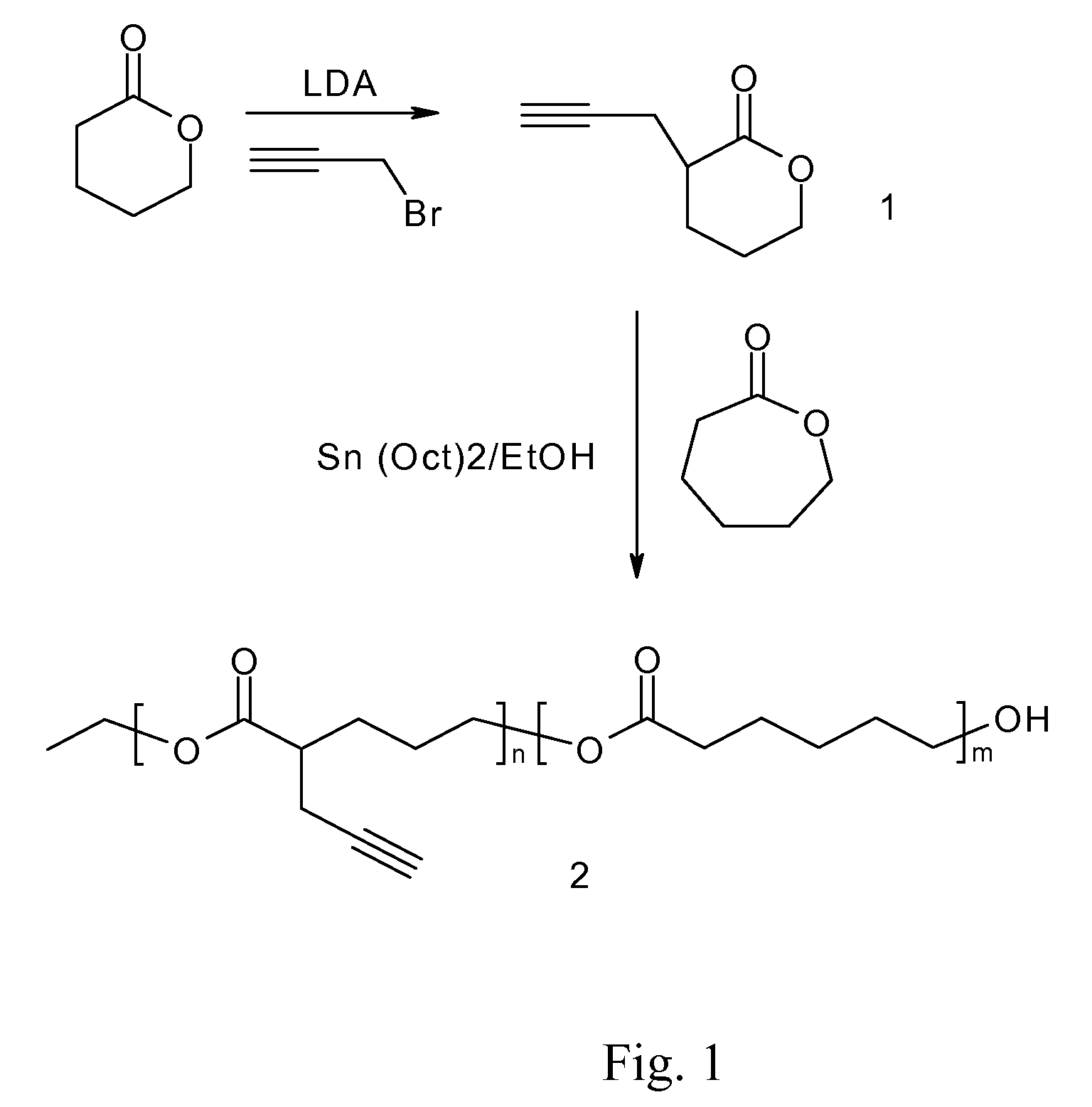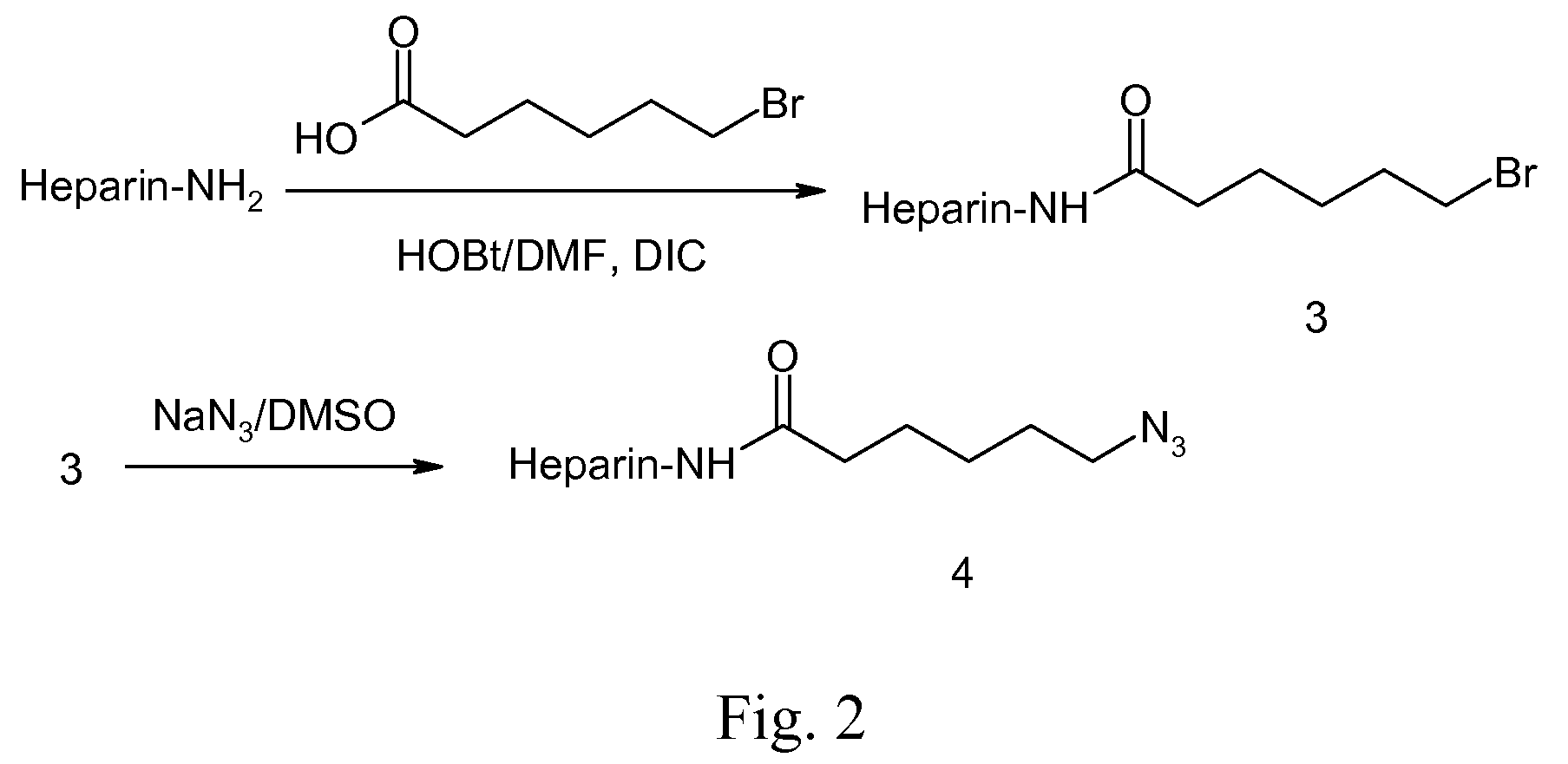Coating Employing an Anti-Thrombotic Conjugate
a technology of conjugate and coating, applied in the field of bioab, can solve the problems of general limited scope of polypropylene, and achieve the effect of fewer transformation steps and greater versatility
- Summary
- Abstract
- Description
- Claims
- Application Information
AI Technical Summary
Benefits of technology
Problems solved by technology
Method used
Image
Examples
example 1
Preparation of an Acetylene-Containing Valerolactone Monomer
[0050]As shown in FIG. 1, a pre-determined amount of delta-valerolactone (technical grade from Aldrich, USA) is reacted with N,N-diisopropylamide (LDA, 99.5+%, Aldrich, USA) in tetrahydrofuran (THF) at −78° C., followed by quenching with a toluene solution of propargyl bromide (80 wt % toluene solution, Aldrich, USA). Kugelrohr distillation of the crude product at 140° C. gave lactone 1 as a colorless, viscous liquid.
example 2
Copolymerization of Valerolactone Having an Acetylene Side Chain with Caprolactone Via a Ring-Opening Polymerization with Ethanol as the Initiator
[0051]Purified valerolacone monomer made in example 1 is copolymerized with epsilon-caprolactone (99+%, Aldrich, USA) in a dried round bottom glass reactor equipped with a magnetic stir bar, with ethanol (anhydrous grade, Aldrich, USA) as the initiator and Sn(OTf)2 as the ring-opening catalyst. The reaction scheme is shown in FIG. 1. The ring-opening polymerization is performed neat or using toluene as solvent at room temperature or at an elevated temperature. The molecular weight of the copolymers increase with time of reaction and the use of Sn(OTf)2 offers a better control of polydispersity of the final copolymer compared with the more conventional Tin-based catalyst such as stannous Octoate. The density of the pendant acetylene group in the block polyester copolymer is adjusted by varying the molar ratio between the valerolactone monom...
example 3
Introduction of an Azide End-Group to a Heparin Molecule
[0053]Azide terminated heparin is synthesized via a route as shown in FIG. 2. Briefly, a solution of bromohexanoic acid and 1-hydroxybenzotriazole (HOBt, <5% water, Aldrich, USA) are added to dry DMF. N,N′-diisoporprylcarbodiimide (DIC, 99%, Aldrich, USA) is added dropwise to the solution and stirred for 20 min. The activated solution is added to a heparin solution in DMF and agitated for 1 hour. The reaction is then filtered to remove solids. The crude product is then concentration by rotary evaporation and precipitated in ether. The precipitate is then washed 3 times with ether and vacuum dried overnight. The bromide-terminated heparin is then dissolved in DMSO and sodium azide is added to the solution. The reaction is allowed to proceed for 12 hours at room temperature after which the solution is filtered. Following rotary evaporation and Kugelrohr distillation to remove DMSO, the crude product is dissolved in a minimal amou...
PUM
| Property | Measurement | Unit |
|---|---|---|
| Thickness | aaaaa | aaaaa |
| Diameter | aaaaa | aaaaa |
| Molecular weight | aaaaa | aaaaa |
Abstract
Description
Claims
Application Information
 Login to View More
Login to View More - R&D
- Intellectual Property
- Life Sciences
- Materials
- Tech Scout
- Unparalleled Data Quality
- Higher Quality Content
- 60% Fewer Hallucinations
Browse by: Latest US Patents, China's latest patents, Technical Efficacy Thesaurus, Application Domain, Technology Topic, Popular Technical Reports.
© 2025 PatSnap. All rights reserved.Legal|Privacy policy|Modern Slavery Act Transparency Statement|Sitemap|About US| Contact US: help@patsnap.com



